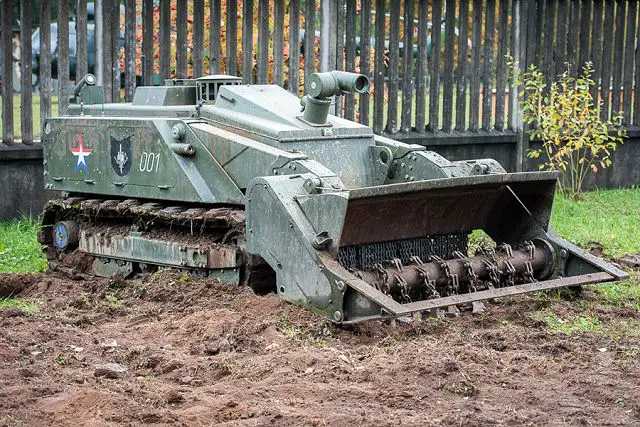|
The Uran-6 (MRTK-R) is a an unmanned multifunctional demining system designed and manufactured by the Russian Defense Industry. The Uran-6 is a Russian version of the Croatian MV-4 Dok-Ing mine-clearing robot. The Uran-6 can do the work of 20 engineer troops. It can carry out its task from at a safe distance of up to 1 km. By the end of the year 2015, the Uran-6 will be delivered to military engineers of the Russian army Southern Military District enabling them to increase effectiveness of their missions in the Chechen Republic of the Republic of Ingushetia by 15%. The system can be easily transported by a truck, a 20ft container or a transport helicopter.
|
| Tools |
|
At the front of the Uran-6, there is one bulldozer blade and trawls. Beside standard Flail tool efficient on all types of terrain, in particular those with vegetation, the Uran-6 can be used with a set of different tool attachments which support its efficiency and multipurpose functions. The Uran-6 can be fitted with a full range of tools, as tiller, segmented roller, dozer blade, gripper, rear forklift, rear shovel and robotic arm. The vehicle is also equipped with different types of mounted instruments as well as 4 cameras for 360-degree view.
|
| Design |
|
The hull structure of the Uran-6 is made of 8mm-10mm thick armour plating. The engine and other key components of the vehicle are protected by HARDOX 400 steel armour plates. Due to the Hardox steel plates, the Uran-6 is highly resistant to the fragmentation of landmines, and it's low profile reduces its susceptibility to shrapnel damage. The impact hammers constructed of steel can resist mine blasts. The Uran-6 is protected against explosion of landmines and firing of small arms 7.62mm NATO caliber.
|
| Mobility |
|
The Uran-6 is motorized by a modified 6-cylinder water cooled, turbo-charged diesel engine. The Uran-6 is based on a tracked chassis, it can run and work at a speed up to 15 km. It is designed to negotiate solid obstacles of 0,8 m high, cross ditches and canals up to 1,2 meters wide and work in swamps up to 0,45 m deep. Small dimensions and low track-ground pressure and the working tool that can be raised, lowered, extended and retracted enable the Uran-6 system to navigate over difficult terrain such as ditches, obstacles, canals, etc. It is able to pass over a ditch 50 cm wide and 30 cm deep, and vertical obstacles of about 30 cm in height. The vehicle consumes 15l-25l of fuel an hour based on soil type and operating procedures.
|
| Combat use |
|
The Uran-6 moves across the dangerous terrain, searches for mines and unexploded ordnance and neutralizes them on the operator's command. Thanks to its technical characteristics, the Uran-6 can neutralize an explosive object with a potential of 130 lbs (59 kg) of TNT equivalent. The Uran-6 is still not fully trusted and is followed by sappers who verify how efficiently the Uran-6 has cleared the zone. The Uran-6 can be controlled up to a distance of 1,500 m and has a battery capacity up to 16 hours. It is also able to perform self-recovery from a ditch/channel by using its hydraulic arms (extend/retract positions).
|
| |
| Specifications |
| Back to top |
|
Tools
|
|
Tiller Tool, Segmented roller, dozer blade, gripper, rear forklift, rear shoveln, robotic arm
|
|
Country users
|
|
Russia
|
|
Designer Country
|
|
Russia - Croatia
|
|
Accessories
|
|
Four cameras
|
|
Crew
|
|
1
|
|
|
Armor
|
|
Protection against explosion of landmines and firing of small arms 7.62mm NATO caliber.
|
|
Weight
|
|
5,310 kg
|
|
Speed
|
|
5 km/h - demining speed 1.26 km /h
|
|
Hours of work
|
|
16 hours
|
|
Dimensions (robot without tools)
|
|
Length: 3.0 m; Width: 1.53 m; Height: 1.47 m
|
|
|
|
| |
|

































